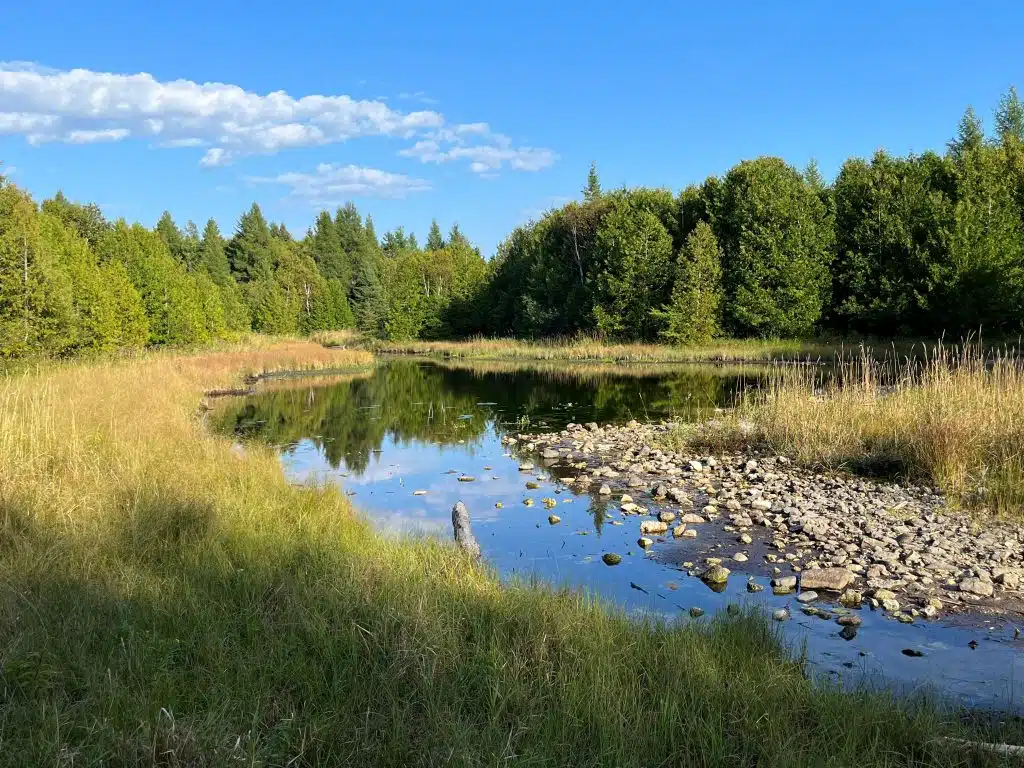Now Streaming: Water Protection
Below the still surface of Door County’s landscape, under and through the bedrock, water moves rapidly—a mixture of rainwater, snow melt, and dissolved particles collected from life above. In many areas, both nutrients and pollutants find their way quickly into the county’s waterways—as well as Lake Michigan and Green Bay—at a rate that can overwhelm nature’s filtration process.
According to Senior Land Protection Manager Terrie Cooper, natural water filtration on land in other places with adequate soil and deep-rooted plants takes hundreds of years rather than Door County’s days, weeks, or months.
“The water immediately drains through the county’s thin soils and bedrock into an underground cave system (karst) where there are tunnels and fractures in the bedrock that the water quickly passes through,” Terrie says. “There’s very little filtration taking place, out into the lake or down into the aquifer, where all our county’s drinking water comes from.”
Door County was once entirely forested with native trees and plants that slowed down runoff. Their root systems helped filter dissolved nutrients and minerals in ground water by pulling them up and using them for their growth. Today, our change in land use, and conversion from native forests to agriculture, residential development, and urban infrastructure compromises water filtration. As the population of Door County continues to grow, so does the threat to water quality. Municipalities have begun to address a major issue: leaking septic tanks. Required septic system inspections are helping, but this does not replace the urgent need for the protection of the forest and wetlands, and the restoration of existing buffers to supply clean water. Three ongoing project areas demonstrate the Land Trust’s commitment to bolstering natural filtration.
Coffey Swamp Natural Area:
The recent donation to the Land Trust of a 10-acre white cedar forest in the Coffey Swamp State Natural Area on Washington Island is key to preserving water quality for Coffey Swamp and Lake Michigan. With the donated forest ideally situated on the rim of the area’s wetland basin, it provides a buffer from future residential development and its potential for sediment and nutrient runoff that could find its way through the wetland to Lake Michigan.
Another important aspect of the forest is that it expands the protection of the migratory bird habitat of Coffey Swamp, which is located on the northern edge of Washington Island and serves as
a critical resting place for migrating birds within the Mississippi Flyway. The area is also home to several rare species associated with boreal-rich fens, as well as those more commonly found such as cottongrass, bog-rosemary, Labrador-tea, and bogbean. Also present are carnivorous plants, including round-leaved sundew and pitcher plant.
Hibbards Creek Natural Area:
Of particular focus to the Land Trust is the Hibbards Creek watershed west of Kangaroo Lake. The protected Erskine Woods, Solitude, and Hibbards Creek Natural Areas lie within this corridor that also facilitates the movement of wildlife across the peninsula. The watershed contains feeder streams, adjacent wetlands, and woodland buffers that follow Hibbards Creek on its way into Lake Michigan. Hibbards Creek is the longest creek in Door County north of Sturgeon Bay.
“These are the veins, the lifeblood that feeds our water,” Terrie says. “You want to have these creeks and wetlands protected to filter what is coming off the land before it goes out into the lake. The corridor has pretty good water quality, but that is changing as more development takes place within the corridor and along the creek bed. We want to work with landowners and do what we can to protect the water quality while we still can.”
Terrie describes the headwaters of Hibbards Creek as “a big sponge, a filter that feeds the creek.” She notes that the spawning of native pike, and rainbow and brook trout indicate this creek has
good water quality.
“There are a lot of native plants and aquatic insects that live in the water under the rocks that are the base of the food chain, and the fish and birds are eating them” Terrie adds. “Protecting these
waterways supports wildlife habitat in Door County.”
DCLT currently protects several properties in the Hibbards Creek corridor and is actively exploring additional land protection opportunities.
Three Springs Natural Area:
The headwaters of Three Springs is another area that promotes clean water, while providing critical habitat for the Hine’s emerald dragonfly. The springs ultimately drain into North Bay in Lake
Michigan. Terrie says, “The quality of water in North Bay is critical to protect.
Just offshore of North Bay is an area
where historically 90% of Lake Michigan’s
whitefish have spawned.”
Terrie also points out the economic impact of protecting Door County’s wetlands and waters. “Municipalities have to build
sewage treatment plants, water filtration plants, and provide flood control—that costs money,” she said. “But if we protect wetlands,
and what’s happening on the ground, that’s a service the Land Trust and all other protected lands in the county are providing naturally.”


